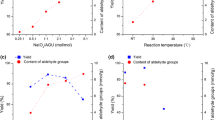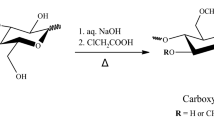Abstract
A facile strategy for preparation of alkyne-functionalized cellulose fibers with click reactivity is reported herein. Poly(3-ethynylaniline) [poly(3-EA)] with pendant alkynyl groups was obtained by chemical oxidation polymerization of 3-ethynylaniline with ammonium persulfate in low-concentration hydrochloric acid solution at ice-bath temperature and used to generate alkyne-functionalized cellulose fibers in situ from pulp fibres. Successful preparation of alkyne-functionalized cellulose fibers was confirmed by attenuated total reflectance Fourier-transform infrared spectroscopy, X-ray photoelectron spectroscopy, and scanning electron microscopy. The effects of process variables on poly(3-EA) deposition and fiber loss were investigated, and suitable preparation conditions identified. Deposition of poly(3-EA) did not change the crystallinity or hydrophilicity of the cellulose fibers. Poly(3-EA) and alkyne-functionalized cellulose fibers reacted with azides by Cu(I)-catalyzed alkyne–azide 1,3-dipolar cycloaddition. Thus, this in situ chemical polymerization technology provides a new platform for click functionalization of cellulose fibers. Applications of cellulose fibers produced in this way are limited to those without demanding requirements in terms of product strength or color.
















Similar content being viewed by others
References
Agag T, Vietmeier K, Chernykh A, Ishida H (2012) Side-chain type benzoxazine-functional cellulose via click chemistry. J Appl Polym Sci 125:1346–1351
Agard NJ, Prescher JA, Bertozzi CR (2004) A strain-promoted [3 + 2] azide-alkyne cycloaddition for covalent modification of biomolecules in living systems. J Am Chem Soc 126:15046–15047
Alila S, Ferraria AM, do Rego AMB, Boufi S (2009) Controlled surface modification of cellulose fibers by amino derivatives using N,N′-carbonyldiimidazole as activator. Carbohydr Polym 77:553–562
Belgacem MN, Gandini A (eds) (2008) Surface modification of cellulose fibres. In: Monomers, polymers and composites from renewable resources. Elsevier, Amsterdam, pp 385–400
Bock VD, Hiemstra H, Van Maarseveen JH (2006) Cu(I)-catalyzed alkyne–azide “click” cycloadditions from a mechanistic and synthetic perspective. Eur J Org Chem 3:51–68
Bodin A, Ahrenstedt L, Fink H, Brumer H, Risberg B, Gatenholm P (2007) Modification of nanocellulose with a xyloglucan-RGD conjugate enhances adhesion and proliferation of endothelial cells: implications for tissue engineering. Biomacromolecules 8:3697–3704
Chen GJ, Tao L, Mantovani G, Ladmiral V, Burt DP, Macpherson JV, Haddleton DM (2007) Synthesis of azide/alkyne-terminal polymers and application for surface functionalisation through a [2 + 3] Huisgen cycloaddition process, “click chemistry”. Soft Matter 3:732–739
Chen ZX, Zhu JT, Xie HB, Li S, Wu YM, Gong YF (2010) Copper(I)-catalyzed synthesis of novel 4-(trifluoromethyl)-[1,2,3]triazolo[1,5-a]quinoxalines via cascade reactions of N-(o-haloaryl)alkynylimine with sodium azide. Adv Synth Catal 352:1296–1300
Chen Y, Qian XR, An XH (2011) Preparation and characterization of conductive paper via in situ polymerization of 3,4-ethylenedioxythiophene. BioResources 6:3410–3423
Derikvand F, Yin DT, Barrett R, Brumer H (2016) Cellulose-based biosensors for esterase detection. Anal Chem 88:2989–2993
Ding CY, Qian XR, Shen J, An XH (2010) Preparation and characterization of conductive paper via in situ polymerization of pyrrole. BioResources 5:303–315
Elchinger PH, Faugeras PA, Boëns B, Brouillette F, Montplaisir D, Zerrouki R, Lucas R (2011) Polysaccharides: the “click” chemistry impact. Polymers 3:1607–1651
Filpponen I, Kontturi E, Nummelin S, Rosilo H, Kolehmainen E, Ikkala O, Laine J (2012) Generic method for modular surface modification of cellulosic materials in aqueous medium by sequential “click” reaction and adsorption. Biomacromolecules 13:736–742
Finn MG, Kolb HC, Fokin VV, Sharpless KB (2008) Click chemistry: definition and aims. Prog Chem 20:1–4
Gandini A, Pasquini D (2012) The impact of cellulose fibre surface modification on some physico-chemical properties of the ensuing papers. Ind Crop Prod 35:15–21
Grigoray O, Wondraczek H, Heikkila E, Fardim P, Heinze T (2014) Photoresponsive cellulose fibers by surface modification with multifunctional cellulose derivatives. Carbohydr Polym 111:280–287
Hafren J, Zou WB, Cordova A (2006) Heterogeneous ‘organoclick’ derivatization of polysaccharides. Macromol Rapid Commun 27:1362–1366
Huang W, Huang JJ, Xu CH, Gu SJ, Xu WL (2014) Surface functionalization of cellulose membrane via heterogeneous “click” grafting of zwitterionic sulfobetaine. Polym Bull 71:2559–2569
Junka K, Filpponen I, Johansson L-S, Kontturi E, Rojas OJ, Laine J (2014) A method for the heterogeneous modification of nanofibrillar cellulose in aqueous media. Carbohydr Polym 100:107–115
Kolb HC, Finn MG, Sharpless KB (2001) Click chemistry: diverse chemical function from a few good reactions. Angew Chem 40:2004–2021
Krouit M, Bras J, Belgacem MN (2008) Cellulose surface grafting with polycaprolactone by heterogeneous click-chemistry. Eur Polym J 44:4074–4081
Lee DG, Chang VS (1979) Oxidation of hydrocarbons. 9. The oxidation of alkynes by potassium permanganate. J Org Chem 44:2726–2730
Lei Y, Qian XR, Shen J, An XH (2012) Integrated reductive/adsorptive detoxification of Cr(VI)-contaminated water by polypyrrole/cellulose fiber composite. Ind Eng Chem Res 51:10408–10415
Li J, Qian XR, Wang LJ, An XH (2010) XPS characterization and percolation behavior of polyaniline-coated conductive paper. BioResources 5:712–726
Liebert T, Hansch C, Heinze T (2006) Click chemistry with polysaccharides. Macromol Rapid Commun 27:208–213
Liu XY, Qian XR, Shen J, Zhou WP, An XH (2012) An integrated approach for Cr(VI)-detoxification with polyaniline/cellulose fiber composite prepared using hydrogen peroxide as oxidant. Bioresour Technol 124:516–519
Ly EB, Bras J, Sadocco P, Belgacem MN, Dufresne A, Thielemans W (2010) Surface functionalization of cellulose by grafting oligoether chains. Mater Chem Phys 120:438–445
Mangiante G, Alcouffe P, Burdin B, Gaborieau M, Zeno E, Petit-Conil M, Bernard J, Charlot A, Fleury E (2013) Green nondegrading approach to alkyne-functionalized cellulose fibers and biohybrids thereof: synthesis and mapping of the derivatization. Biomacromolecules 14:254–263
Mao H, Wu XN, Qian XR, An XH (2014) Conductivity and flame retardancy of polyaniline-deposited functional cellulosic paper doped with organic sulfonic acids. Cellulose 21:697–704
Meng X, Edgar KJ (2016) “Click” reactions in polysaccharide modification. Prog Polym Sci 53:52–85
Ogata Y, Sawaki Y, Ohno T (1982) Mechanism for oxidation of phenylacetylenes with peroxymonophosphoric acid. Oxirene as an intermediate inconvertible to ketocarbene. J Am Chem Soc 104:216–219
Paquet O, Krouit M, Bras J, Thielemans W, Belgacem MN (2010) Surface modification of cellulose by PCL grafts. Acta Mater 58:792–801
Pohl M, Morris GA, Harding SE, Heinze T (2009) Studies on the molecular flexibility of novel dendronized carboxymethyl cellulose derivatives. Eur Polym J 45:1098–1110
Roy D, Semsarilar M, Guthrie JT, Perrier S (2009) Cellulose modification by polymer grafting: a review. Chem Soc Rev 38:2046–2064
Stejskal J, Gilbert RG (2002) Polyaniline. Preparation of a conducting polymer. Pure Appl Chem 74:857–867
Tang JS, Wang LX, Jing XB, Wang FS (1989) The effect of acid concentration on the aniline polymerization and the characterization of polymers obtained. Acta Polym Sin 2:188–191
van Berkel SS, Dirks ATJ, Debets MF, van Delft FL, Cornelissen JJLM, Nolte RJM, Rutjes FPJT (2007) Metal-free triazole formation as a tool for bioconjugation. ChemBioChem 8:1504–1508
Xiong FQ, Han YM, Li GY, Qin TF, Wang SQ, Chu FX (2016) Research status of click chemistry used for chemical modification of lignocellulose. Sci Silvae Sin 52:90–96
Xu C, Spadiut O, Silva ACA, Brumer H (2012) Chemo-enzymatic assembly of clickable cellulose surfaces via multivalent polysaccharides. ChemSusChem 5:661–665
Yilmaz F, Kucukyavuz Z (2013) The influence of polymerization temperature on structure and properties of polyaniline. E-Polymers 9:48–57
Zampano G, Bertoldo M, Bronco S (2009) Poly(ethyl acrylate) surface-initiated ATRP grafting from wood pulp cellulose fibers. Carbohydr Polym 75:22–31
Zhao GL, Hafren J, Deiana L, Cordova A (2010) Heterogeneous “organoclick” derivatization of polysaccharides: photochemical thiol-ene click modification of solid cellulose. Macromol Rapid Commun 31:740–744
Zhou Q, Baumann MJ, Brumer H, Teeri TT (2006) The influence of surface chemical composition on the adsorption of xyloglucan to chemical and mechanical pulps. Carbohydr Polym 63:449–458
Zhou Q, Rutland MW, Teeri TT, Brumer H (2007) Xyloglucan in cellulose modification. Cellulose 14:625–641
Acknowledgments
The authors gratefully acknowledge the National Natural Science Foundation of China (grant no. 31370579) for financial support of this work.
Author information
Authors and Affiliations
Corresponding author
Rights and permissions
About this article
Cite this article
Xiao, G., Ding, C., Song, F. et al. Facile strategy for preparation of alkyne-functionalized cellulose fibers with click reactivity. Cellulose 24, 591–607 (2017). https://doi.org/10.1007/s10570-016-1153-1
Received:
Accepted:
Published:
Issue Date:
DOI: https://doi.org/10.1007/s10570-016-1153-1




